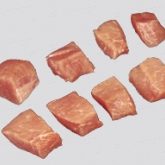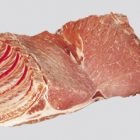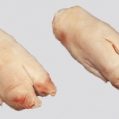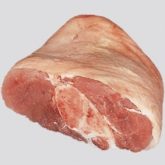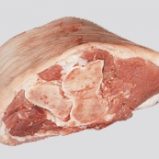 The loin is that portion of the side remaining after removal of the shoulder, leg, belly and fat back, leaving a portion of the blade bone, its overlying lean and fat. There shall be not less than two sacral, but no caudal vertebrae left remaining on the loin. The shoulder and leg shall be separated from the loin by straight cuts which are reasonably perpendicular to the split surface of the backbone.
The loin is that portion of the side remaining after removal of the shoulder, leg, belly and fat back, leaving a portion of the blade bone, its overlying lean and fat. There shall be not less than two sacral, but no caudal vertebrae left remaining on the loin. The shoulder and leg shall be separated from the loin by straight cuts which are reasonably perpendicular to the split surface of the backbone.
The outer tip of subscapularis muscle shall not extend past the center of the base of the medial ridge of the blade bone. The belly side shall be removed by a straight cut (a slight dorsal curvature is acceptable) which extends from a point which is ventral to but not more than 3.0 inches (7.5 cm) from the longissimus on the shoulder end, to a point on the leg end ventral to but not more than 0.5 inch (13 mm) form the tenderloin.
Surface fat shall be trimmed to an average of 0.25 inch (6 mm) in depth or less except in the hip bone area. The hip bone area is defined as the area contained within two parallel lines, 2.0 inches (5.0 cm) on either side of the anterior end of the hip bone associated cartilage. Fat in the hip bone area shall be trimmed to the same contour as the rest of the trimmed fat surface of the loin. At least 2.0 inches (5.0 cm) of the false lean shall be exposed. Lumbar and pelvic fat shall be trimmed to 0.5 inch (13 mm) or less in depth. The tenderloin shall remain intact. The diaphragm and hanging tender shall be excluded. The spinal cord groove shall be evident on at least 75 percent of the vertebrae.


